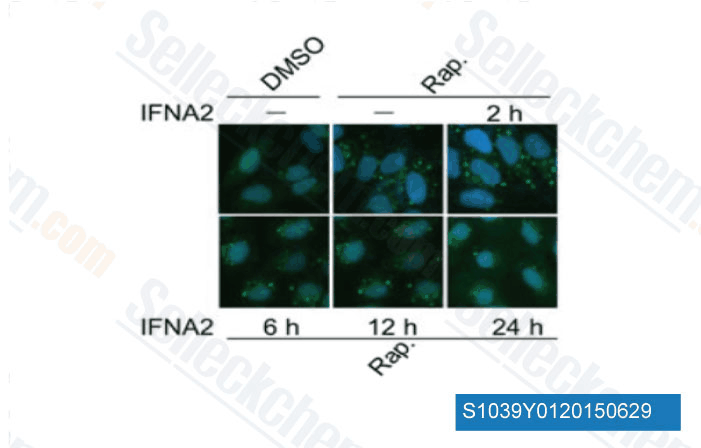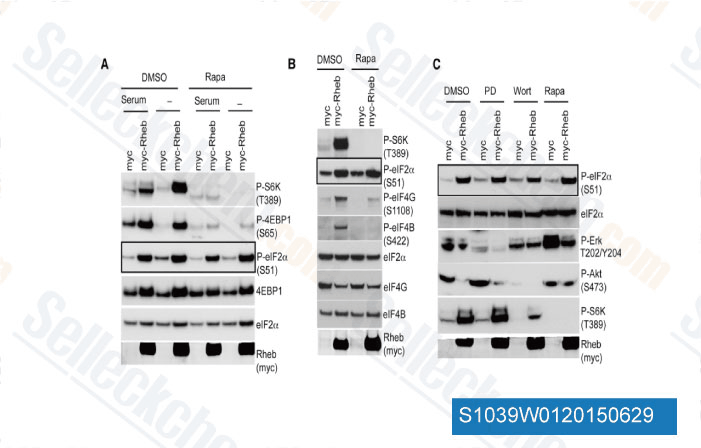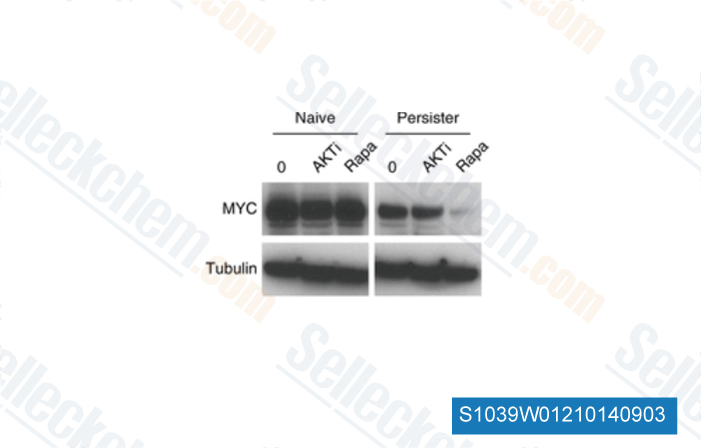|
Toll Free: (877) 796-6397 -- USA and Canada only -- |
Fax: +1-832-582-8590 Orders: +1-832-582-8158 |
Tech Support: +1-832-582-8158 Ext:3 Please provide your Order Number in the email. |
Technical Data
| Formula | C51H79NO13 |
|||
| Molecular Weight | 914.18 | CAS No. | 53123-88-9 | |
| Solubility (25°C)* | In vitro | DMSO | 100 mg/mL (109.38 mM) | |
| Ethanol | 100 mg/mL (109.38 mM) | |||
| Water | Insoluble | |||
|
* <1 mg/ml means slightly soluble or insoluble. * Please note that Selleck tests the solubility of all compounds in-house, and the actual solubility may differ slightly from published values. This is normal and is due to slight batch-to-batch variations. * Room temperature shipping (Stability testing shows this product can be shipped without any cooling measures.) |
||||
Preparing Stock Solutions
Biological Activity
| Description | Rapamycin is a specific mTOR inhibitor with IC50 of ~0.1 nM in HEK293 cells.Rapamycin binds to FKBP12 and specifically acts as an allosteric inhibitor of mTORC1. Rapamycin is an autophagy activator and an immunosuppressant. | ||
|---|---|---|---|
| Targets |
|
||
| In vitro | Rapamycin inhibits endogenous mTOR activity in HEK293 cells with IC50 of ~0.1 nM, more potently than iRap and AP21967 with IC50 of ~5 nM and ~10 nM, respectively. [1] In Saccharomyces cerevisiae, Rapamycin treatment induces a severe G1/S cell cycle arrest and inhibition of translation initiation to levels below 20% of control. [2] Rapamycin significantly inhibits the cell viability of T98G and U87-MG in a dose-dependent manner with IC50 of 2 nM and 1 μM, respectively, while displaying little activity against U373-MG cells with IC50 of >25 μM despite the similar extent of the inhibition of mTOR signaling. Rapamycin (100 nM) induces G1 arrest and autophagy but not apoptosis in Rapamycin-sensitive U87-MG and T98G cells by inhibiting the function of mTOR. [3] |
||
| In vivo | Treatment with Rapamycin in vivo specifically blocks targets known to be downstream of mTOR such as the phosphorylation and activation of p70S6K and the release of inhibition of eIF4E by PHAS-1/4E-BP1, leading to complete blockage of the hypertrophic increases in plantaris muscle weight and fibre size. [4] Short-term Rapamycin treatment, even at the lowest dose of 0.16 mg/kg, produces profound inhibition of p70S6K activity, which correlates with increased tumor cell death and necrosis of the Eker renal tumors. [5] Rapamycin inhibits metastatic tumor growth and angiogenesis in CT-26 xenograft models by reducing the production of VEGF and blockage of VEGF-induced endothelial cell signaling. [6] Rapamycin treatment at 4 mg/kg/day significantly reduces tumor growth of C6 xenografts, and tumor vascular permeability. [7] |
Protocol (from reference)
| Kinase Assay: |
|
|---|---|
| Cell Assay: |
|
| Animal Study: |
|
References
Customer Product Validation

-
Data from [Data independently produced by Autophagy, 2015, 11(4), 617-28]

-
Data from [Data independently produced by Cell Rep, 2015, 10.1016/j.celrep.2015.01.014]

-
Data from [Data independently produced by Biochem Pharmacol, 2015, 95(3), 156-69]

-
Data from [Nat Genet, 2014, 46(4), 364-70]
Selleck's Rapamycin has been cited by 2100 publications
| Interferon-responsive intestinal BEST4/CA7+ cells are targets of bacterial diarrheal toxins [ Cell Stem Cell, 2025, S1934-5909(25)00042-6] | PubMed: 40010349 |
| USP5 stabilizes YTHDF1 to control cancer immune surveillance through mTORC1-mediated phosphorylation [ Nat Commun, 2025, 16(1):1313] | PubMed: 39900921 |
| Lysosomal NKG7 restrains mTORC1 activity to promote CD8+ T cell durability and tumor control [ Nat Commun, 2025, 16(1):1628] | PubMed: 39952956 |
| Extracellular Histones as Exosome Membrane Proteins Regulated by Cell Stress [ J Extracell Vesicles, 2025, 14(2):e70042] | PubMed: 39976275 |
| ROR1 CAR-T cells and ferroptosis inducers orchestrate tumor ferroptosis via PC-PUFA2 [ Biomark Res, 2025, 13(1):17] | PubMed: 39849645 |
| Zinc Alleviates Diabetic Muscle Atrophy via Modulation of the SIRT1/FoxO1 Autophagy Pathway Through GPR39 [ J Cachexia Sarcopenia Muscle, 2025, 16(2):e13771] | PubMed: 40026072 |
| Molecular control of PDPNhi macrophage subset induction by ADAP as a host defense in sepsis [ JCI Insight, 2025, e186456] | PubMed: 39903516 |
| Effects of pesticide dichlorvos on liver injury in rats and related toxicity mechanisms [ Ecotoxicol Environ Saf, 2025, 290:117747] | PubMed: 39823667 |
| α-Synuclein Degradation in Brain Pericytes Is Mediated via Akt, ERK, and p38 MAPK Signaling Pathways [ Int J Mol Sci, 2025, 26(4)1615] | PubMed: 40004079 |
| Vaccinia growth factor-dependent modulation of the mTORC1-CAD axis upon nutrient restriction [ J Virol, 2025, 99(2):e0211024] | PubMed: 39817770 |
RETURN POLICY
Selleck Chemical’s Unconditional Return Policy ensures a smooth online shopping experience for our customers. If you are in any way unsatisfied with your purchase, you may return any item(s) within 7 days of receiving it. In the event of product quality issues, either protocol related or product related problems, you may return any item(s) within 365 days from the original purchase date. Please follow the instructions below when returning products.
SHIPPING AND STORAGE
Selleck products are transported at room temperature. If you receive the product at room temperature, please rest assured, the Selleck Quality Inspection Department has conducted experiments to verify that the normal temperature placement of one month will not affect the biological activity of powder products. After collecting, please store the product according to the requirements described in the datasheet. Most Selleck products are stable under the recommended conditions.
NOT FOR HUMAN, VETERINARY DIAGNOSTIC OR THERAPEUTIC USE.
